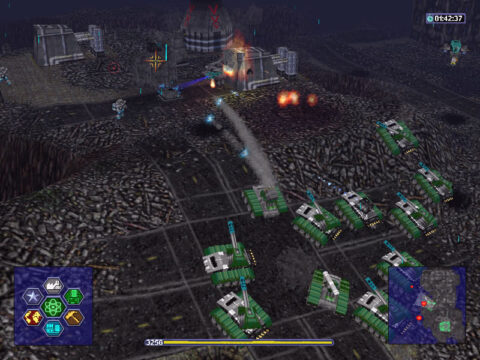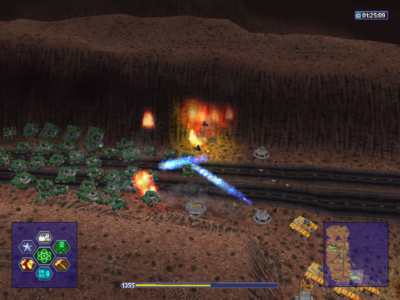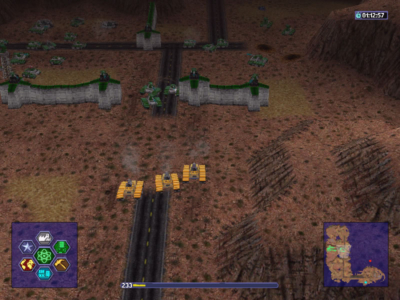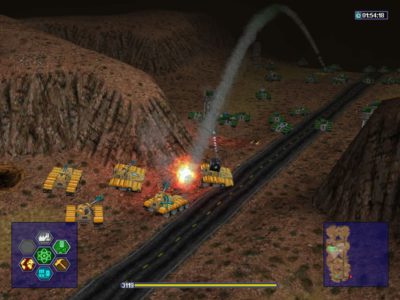
Warzone 2100
Written by: Stoo
Date posted: April 9, 2003
- Genre: Strategy
- Developed by: Pumpkin Studios
- Published by: Eidos
- Year released: 1999
- Our score: 8
Here’s a storyline that seems firmly in the “jotted on the back on an envelope during lunch-break” category: A nuclear holocaust caused by malfunctioning missile-armed satellites wipes out most of civilisation. Several years later a small group calling themselves the Project sets off on a mission to regain lost technologies and rebuild society. They are opposed by the New Paradigm and the Collective, but these two factions may just be pawns of the deranged Artificial Intelligence known as Nexus, that wishes to see the last vestiges of humanity finally wipes out.
Now then, the Real Time Strategy genre hasn’t evolved particularly fast since Dune2 emerged way back in the Amiga days. By the time Warzone 2100 emerged, gameplay had largely the same core: pull cash out of the ground, build little factories, churn out tanks, all in a real-time engine. Still, if the genre lacked revolution, there was at least quite a lot of slow-but-steady evolution taking place, and Warzone is a good example of new ideas being inserted into the mix.
Perhaps the first distinguishing feature that you’ll notice in Warzone is the vehicle-design system. You’re not just given tanks, scout cars and field guns in this game. Instead, you design them yourself through a simple set of menus. First you pick a body for your new war machine, with several variations on the small and cheap, mid-sized and heavyweight themes. Next, choose a means of propulsion. Wheels are cheap and speedy, a tracked vehicle is ponderous but can take more damage, while hovercrafts are flimsy but agile. Finally, you must of course pick a weapon (and the choice is huge) or alternatively you might want to add one of several useful utility items. Throughout the game technology is fed to you slowly through a fairly standard research system: capture little crates at destroyed enemy bases, and then set your research buildings to work on them. Early on your forces will mostly be light wheeled units with basic machine guns or cannon, but as you progress some much more devastating toys become available, and when a battery of tanks lets rip in unison, the effects can be pretty impressive.overwhelming force.
Special attention should be drawn to artillery, as Warzone is one of the few games of this sort to make a decent attempt at implementing such a feature. There’s quite a selection of ballistic weapons: mortars, howitzers and rocket launchers, which vary in range and rate of fire. The clever bit is this: rather than directly ordering these big guns to attack an enemy, you can assign them to a dedicated unarmed scout car. This can ‘see’ further than other units, and when you click on a target for it (as you would to attack with a normal tank), it passes orders to your big guns, who rain ordinance from a safe distance. If the scout gets caught and destroyed, then the artillery can then hopefully disappear back to safe ground, with a good headstart on any pursuing enemies.
…or maybe not. You see, Pumpkin Studios took the idea further with counter-batteries. As an alternative to using your static or vehicular artillery with a radar, you can assign them to a counter-battery system (again mounted on a tower or vehicle). This will automatically send your batteries firing at the unseen launchers of any incoming enemy artillery fire. If anything, counter-batteries are almost too powerful as their version of the ‘scout car’ doesn’t need to be within visual range of the enemy. Still, this system means you usually can’t just sit back and demolish enemy bases from a safe distance without fear of retaliation, which if you think about it would get quite dull after a while.
Next new idea: commanders. These are not actually unique units that must be kept alive to comply with victory conditions (as in Starcraft) but rather a support unit with a specific purpose on the battlefield. Commanders are unarmed ground vehicles, the turret being replaced with a handy targeting system. A number of armed vehicles can then be ordered to follow the Commander around, and instead of giving orders to the whole unruly mob, you just tell the Commander where to go. When ordered to ‘attack’ an enemy, the Commander will spotlight it with a kind of targeting-beam and the attendant tanks will obediently fire on that target with notably increased accuracy. As a Commander oversees more kills, it gains rank and can lead a larger group of units.
Warzone 2100 also slightly modified the old “build base, build forces, rush enemy with tanks, repeat” formula. There are three campaigns in the game, subdivided into missions, and in each campaign you only have one or two major bases to establish. What’s clever is that mission 1 of a campaign might be to build the base on a fairly small map, and then the next few missions expand that map to reveal new enemy fortifications. Also, some missions require you to sent units on a transport to a new map, to strike an enemy base. While you can’t build factories on the new map, your factories back at base can still be ordered to build units, which can be shipped in every few minutes to reinforce your strike force.
A look at the screenshots should reveal another example of how Warzone 2100 differed from its predecessors: it’s in full 3D. Total Annihilation might have taken the first steps in this direction in 1997, but despite it’s polygon tanks our view of the actions was still fixed top-down, overhead. By the time of Warzone technology, though had advanced sufficiently to allow us to enjoy full spinning-tilting-zooming-o-vision (that’s the technical term). How useful such features are is another question. Usually a dramatic “tanks-eye” view of the action makes the raging battle seem much more impressive, being amongst your units as shells rain down and explosions shake the earth. However, it’s pretty useless for getting a clear view of how a battle is progressing and handing out orders, and you’ll probably most of the game in a traditional overhead-view. Still, it’s fun to have the option at least, and the freedom to move and position your ‘camera’ around a three-dimensional world always adds a feeling of realism to the proceedings.
Anyhow, for its time Warzone looked quite impressive with rolling terrain for tanks to trundle over, dotted with hills and ruined buildings. The weapons effects are pretty decent too, especially artillery rockets trailing smoke as they arc across their trajectory. Unfortunately the units themselves look very boxy and a bit homogenous, many of them being essentially a block with tracks and a turret on top. It can sometimes be tricky to quickly tell your creations apart, which doesn’t help if you’re in the middle of a crisis with enemy tanks pounding on your walls.
In short, Warzone2100 offers some solid warmongering, and made at least some small efforts to advance the genre. Some aspects of old remain deeply entrenched; in many missions it’s a good old-fashioned tank rush that works best for breaking the enemy, rather than cunning tricks. This can get a bit frustrating in the last campaign, where Nexus has greatly superior technology to your own and bases laid out to counter every possible kind of attack, forcing you to resort to brute force and constantly churn out replacements for your swiftly-killed tanks. Still, there was enough original thought put into Warzone to make it for the most part highly enjoyable to play. It was later eclipsed by the likes of Homeworld, but Warzone still stands well against the RTS games of today, and even makes some more recent attempts look a bit pedestrian.





 Posts
Posts
It’s worth to point out that Warzone 2100 is Free and Open Source (has been for a long time actually).
That said, you should be able to legally download a copy at:
https://wz2100.net/
June 2, 2015 @ 3:51 pm
Hey thanks for the info. I try to update these old pages as games are added to gog.com or released as freeware, but I inevitably miss a few.
June 2, 2015 @ 5:34 pm